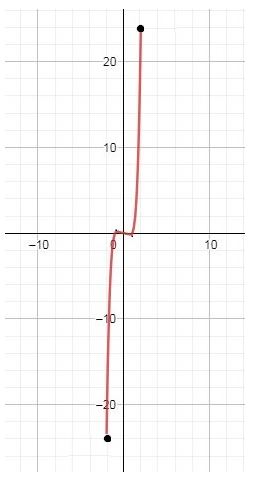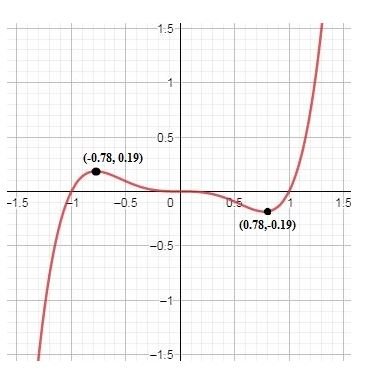
Concept explainers
In Problems 57-64, use a graphing utility to graph each function over the indicated interval and approximate any
59.
To find: The following values using the given graph,
a. Draw the graph using graphing utility and determine the local maximum and minimum values.
Answer to Problem 55AYU
a. Local maximum point is and local minimum is .
Explanation of Solution
Given:
It is asked to draw the graph using graphing utility and determine the local maximum and minimum values and also find the increasing and decreasing intervals of the given function.
Calculation:


a. By the definition of local maximum, “Let be a function defined on some interval . A function has a local maximum at if there is an open interval containing so that, for all in this open interval, we have . We call a local maximum value of ”, It can be directly concluded from the graph and the definition that the curve has local maximum point at .
The value of the local maximum at is .
Therefore, the local maximum point is .
By the definition of local minimum, “Let be a function defined on some interval . A function has a local minimum at if there is an open interval containing so that, for all in this open interval, we have . We call a local minimum value of ”, It can be directly concluded from the graph and the definition that the curve has local minimum point at .
The value of the local minimum point at is .
Therefore, the local minimum point is .
To find: The following values using the given graph,
b. Increasing and decreasing intervals of the function .
Answer to Problem 55AYU
b. The function is increasing in the intervals and and the function is decreasing in the interval . There is no constant interval in the given graph.
Explanation of Solution
Given:
It is asked to draw the graph using graphing utility and determine the local maximum and minimum values and also find the increasing and decreasing intervals of the given function.
Graph:


Calculation:
b. Increasing intervals, decreasing intervals and constant interval if any.
It can be directly concluded from the graph that the curve is increasing from to , then decreasing from to and at last increasing from to 2.
Therefore, the function is increasing in the intervals and and the function is decreasing in the interval . There is no constant interval in the given graph.
Chapter 2 Solutions
Precalculus Enhanced with Graphing Utilities
Additional Math Textbook Solutions
Calculus: Early Transcendentals (2nd Edition)
Algebra and Trigonometry (6th Edition)
Introductory Statistics
University Calculus: Early Transcendentals (4th Edition)
Elementary Statistics (13th Edition)
- A 20 foot ladder rests on level ground; its head (top) is against a vertical wall. The bottom of the ladder begins by being 12 feet from the wall but begins moving away at the rate of 0.1 feet per second. At what rate is the top of the ladder slipping down the wall? You may use a calculator.arrow_forwardExplain the focus and reasons for establishment of 12.4.1(root test) and 12.4.2(ratio test)arrow_forwarduse Integration by Parts to derive 12.6.1arrow_forward
- Explain the relationship between 12.3.6, (case A of 12.3.6) and 12.3.7arrow_forwardExplain the key points and reasons for the establishment of 12.3.2(integral Test)arrow_forwardUse 12.4.2 to determine whether the infinite series on the right side of equation 12.6.5, 12.6.6 and 12.6.7 converges for every real number x.arrow_forward
- use Corollary 12.6.2 and 12.6.3 to derive 12.6.4,12.6.5, 12.6.6 and 12.6.7arrow_forwardExplain the focus and reasons for establishment of 12.5.1(lim(n->infinite) and sigma of k=0 to n)arrow_forwardExplain the focus and reasons for establishment of 12.5.3 about alternating series. and explain the reason why (sigma k=1 to infinite)(-1)k+1/k = 1/1 - 1/2 + 1/3 - 1/4 + .... converges.arrow_forward
 Calculus: Early TranscendentalsCalculusISBN:9781285741550Author:James StewartPublisher:Cengage Learning
Calculus: Early TranscendentalsCalculusISBN:9781285741550Author:James StewartPublisher:Cengage Learning Thomas' Calculus (14th Edition)CalculusISBN:9780134438986Author:Joel R. Hass, Christopher E. Heil, Maurice D. WeirPublisher:PEARSON
Thomas' Calculus (14th Edition)CalculusISBN:9780134438986Author:Joel R. Hass, Christopher E. Heil, Maurice D. WeirPublisher:PEARSON Calculus: Early Transcendentals (3rd Edition)CalculusISBN:9780134763644Author:William L. Briggs, Lyle Cochran, Bernard Gillett, Eric SchulzPublisher:PEARSON
Calculus: Early Transcendentals (3rd Edition)CalculusISBN:9780134763644Author:William L. Briggs, Lyle Cochran, Bernard Gillett, Eric SchulzPublisher:PEARSON Calculus: Early TranscendentalsCalculusISBN:9781319050740Author:Jon Rogawski, Colin Adams, Robert FranzosaPublisher:W. H. Freeman
Calculus: Early TranscendentalsCalculusISBN:9781319050740Author:Jon Rogawski, Colin Adams, Robert FranzosaPublisher:W. H. Freeman
 Calculus: Early Transcendental FunctionsCalculusISBN:9781337552516Author:Ron Larson, Bruce H. EdwardsPublisher:Cengage Learning
Calculus: Early Transcendental FunctionsCalculusISBN:9781337552516Author:Ron Larson, Bruce H. EdwardsPublisher:Cengage Learning





